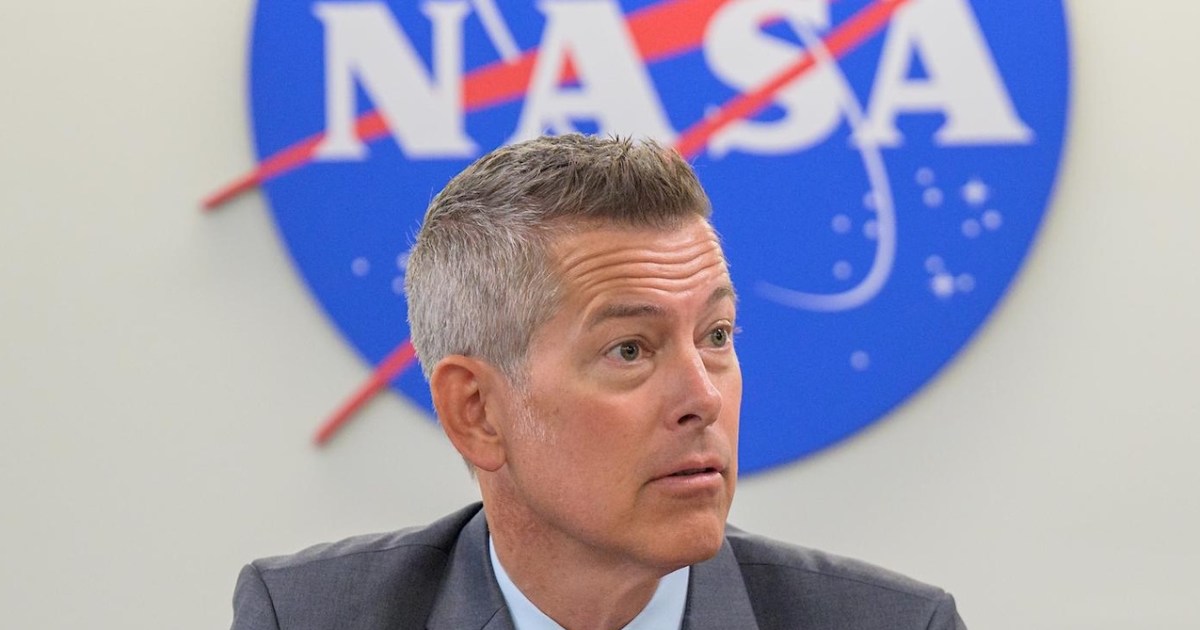Sign up for the Starts With a Bang newsletter
Travel the universe with Dr. Ethan Siegel as he answers the biggest questions of all.
Back in 1957, something spectacular happened that would change the world forever: the first human-created satellite, Sputnik 1, was launched into space. Orbiting our planet in low-Earth orbit, its unique signatures could be seen across the world. Unlike the stars, planets, or meteors that illuminated the night sky, this artificial satellite would glow with the reflected light of the Sun, streaking across the skies overhead whenever it passed within a couple of hundred kilometers of an observer’s location. This momentous occasion marked the birth of the space age, and in 1958, the United States responded in legendary fashion.
Rushing to catch up, the first US space probe — Explorer 1 — was launched in February of 1958. On July 29 of that year, President Eisenhower since the National Aeronautics and Space Act of 1958 into law, establishing the foundation for space policy and bringing NASA, the National Aeronautics and Space Administration, into existence. In all the time since, adhering to the vision of its charter, NASA has been responsible for some of the greatest achievements in human history, including from both an exploration and a scientific viewpoint.
And now, here in August of 2025, acting NASA chief Sean Duffy just announced the intention to terminate all science activities except those related to spaceflight. It’s an extinction-level event for American science, one that will surely destroy arguably the greatest organization symbolizing science and progress in all of history.
Apollo 11 brought humans onto the surface of the Moon for the first time in 1969. Shown here is Buzz Aldrin setting up the Solar Wind experiment as part of Apollo 11, with Neil Armstrong snapping the photograph.
It’s no secret that achievements in human spaceflight is the crown jewel of what NASA has accomplished over its 67 year history. From the early days of Alan Shepard (the first American in space) and John Glenn (the first American to circle the world from space), the 1960s saw the USA rapidly develop through the Mercury, Gemini, and Apollo eras to bring humans to the Moon: first circling it with 1968’s Apollo 8 and then setting foot on it in six missions from 1969-1972. The 1980s saw the rise of the Space Shuttle, which led to 135 missions in space, ending only in 2011. The International Space Station, still in operations today, was begun in 1998, and has led to a 24 year (and counting) unbroken streak of continuous human habitation in space.
But NASA is so much more than rockets and astronauts, even if that’s the most enduring image most of us have in our minds when we think about the space agency. In fact, right there in NASA’s charter, there are explicit orders that the National Aeronautics and Space Administration shall:
- plan, direct, and conduct aeronautical and space activities,
- arrange for participation by the scientific community in planning scientific measurements and observations to be made through use of aeronautical and space vehicles,
- conduct or arrange for the conduct of such measurements and observations,
- and provide for the widest practicable and appropriate dissemination of information concerning its activities and the results thereof.
In other words, science, as well as science communication and education, has always been a major part of NASA’s mission, going all the way back to the charter that created it.
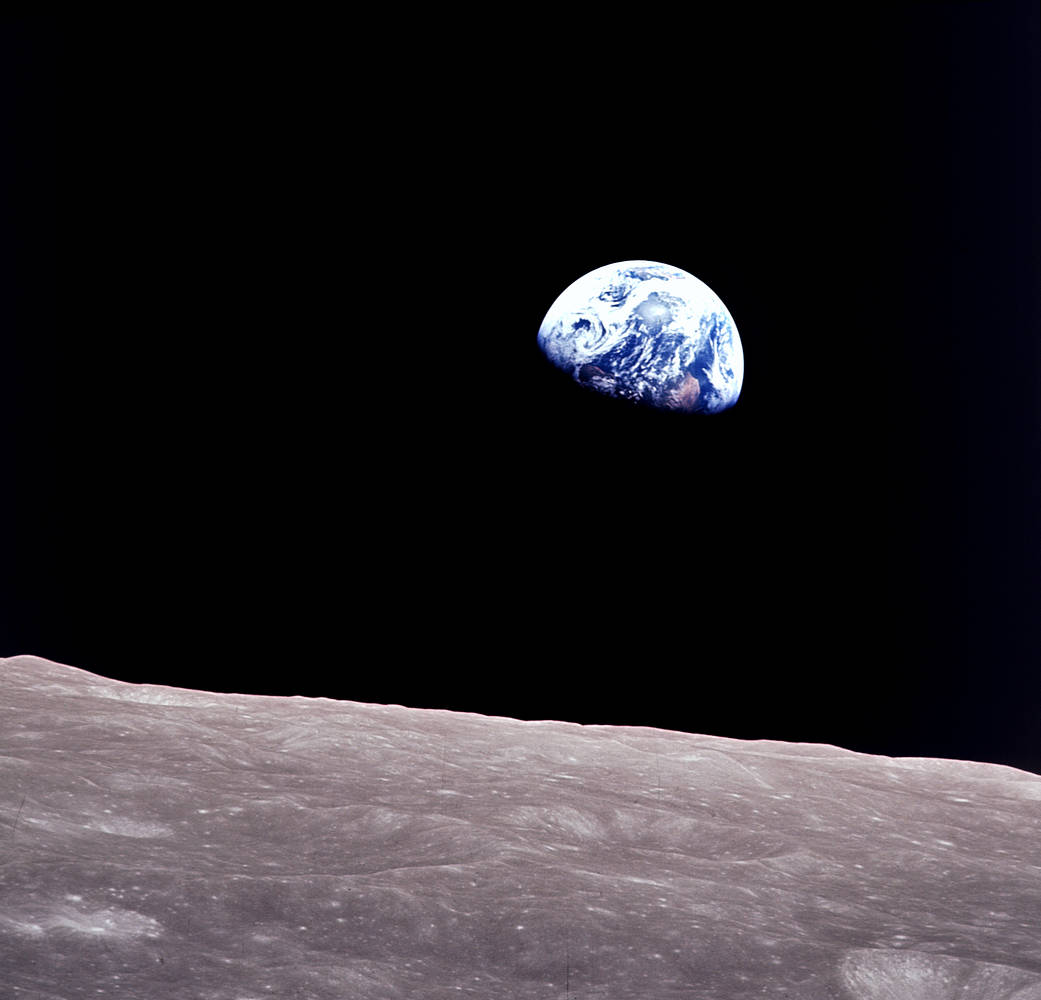
This photograph shows the first view, with human eyes, of the Earth rising over the limb of the Moon, taken mere minutes after the original Earthrise photo (in black-and-white) was snapped. The discovery of the Earth from space, with human eyes, remains one of the most iconic achievements in our species’ history. Apollo 8, which occurred during December of 1968, was one of the essential precursor missions to a successful Moon landing. This photo is arguably the most environmentally impactful one ever taken.
In fact, if you go all the way back to the Declaration of Policy and Purpose of that original 1958 space act, the very first objective of the aeronautical and space activities of the United States is explicitly stated to be:
“The expansion of human knowledge of phenomena in the atmosphere and space.”
For all 67 years of NASA’s history, this hasn’t been up for debate. The purpose of NASA and all space activities conducted in the United States is to expand human knowledge, specifically about phenomena in the atmosphere and in space. The “how” of getting it done is explicitly by arranging for the scientific community’s participation and engagement in both the planning of those scientific endeavors and in the conducting of those measurements and observations. And the knowledge and results of all of those experiments and observatories shall be disseminated as widely as practically possible.
While you might think of “spaceflight” and “humans in space” when you think about NASA, that’s only part of the story. Just as importantly, and perhaps more importantly, it’s about expanding human knowledge, using the best (scientific) tools and know-how that humans have acquired, and with sharing the results of those endeavors as widely and freely as possible.
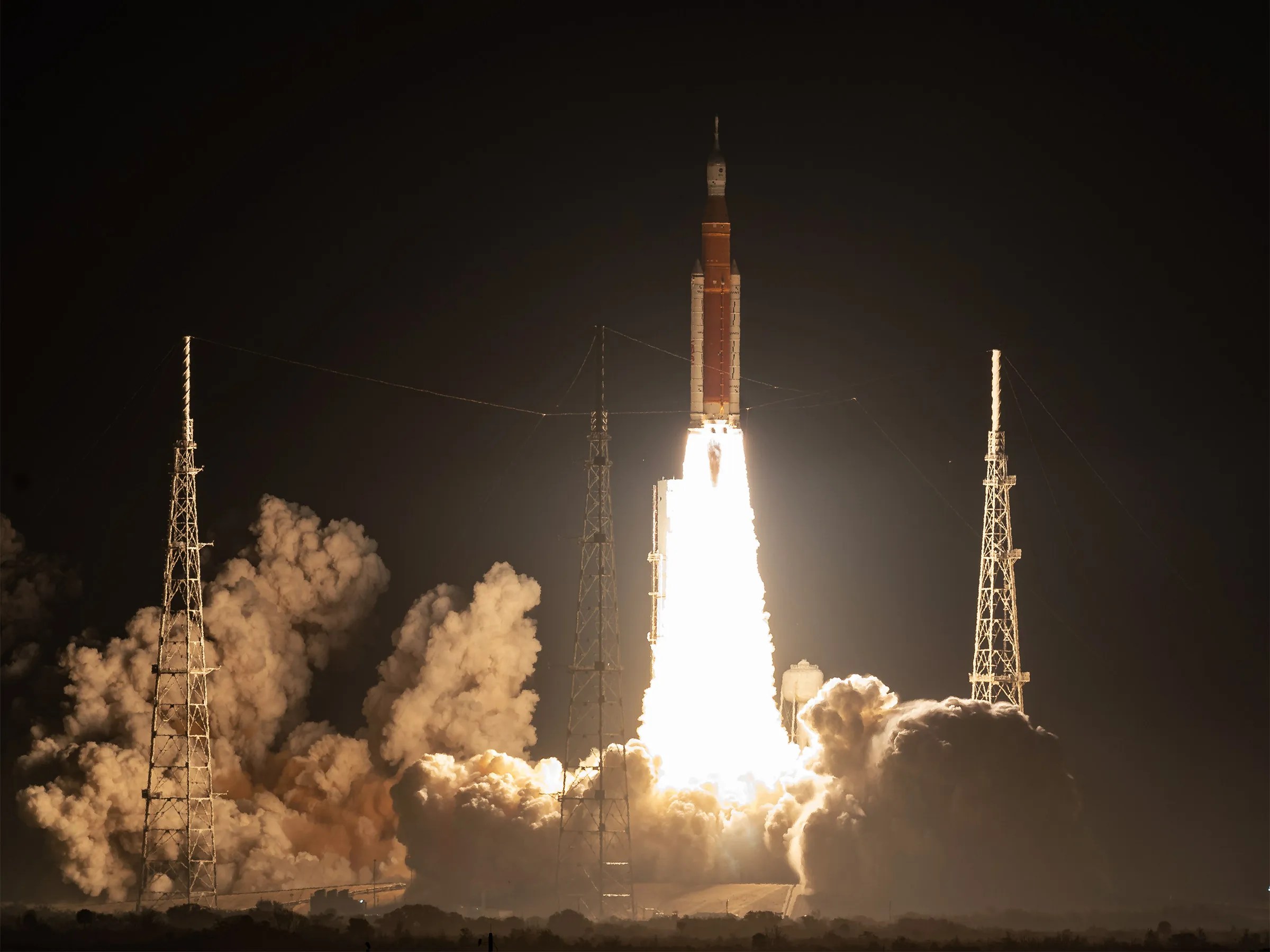
The launch of NASA’s Space Launch System (SLS) rocket, carrying the Orion spacecraft, occurred on November 16, 2022. The Artemis mission is planned to bring humans to the Moon for the first time since the end of the Apollo program a half-century ago, and represents the largest crewed spaceflight endeavor under the NASA umbrella, aside from the International Space Station, since the end of the Space Shuttle era.
All of this is right there, for anyone and everyone to read, in the original 1958 charter for NASA. While some aspects (like salaries and specific structural features) of that charter have since been amended, those core policies and purposes have remained intact, unchanged, for all 67 years of NASA’s history.
Somehow, all of that is on the verge of changing: not because NASA’s charter has changed, been amended further, or abolished by law. Rather, the news was broken when acting NASA administrator Sean Duffy, selected to serve on July 9, 2025, appeared on the Fox Business channel’s Mornings with Maria (Baritromo) show on August 14, 2025, and announced:
Explicitly, Duffy himself stated,
“All the climate science and all of the other priorities that the last administration had at NASA we’re going to move aside, and all of the science that we do is going to be directed towards exploration, which is the mission of NASA… That’s why we have NASA — is to explore, not to do all of these Earth sciences.”
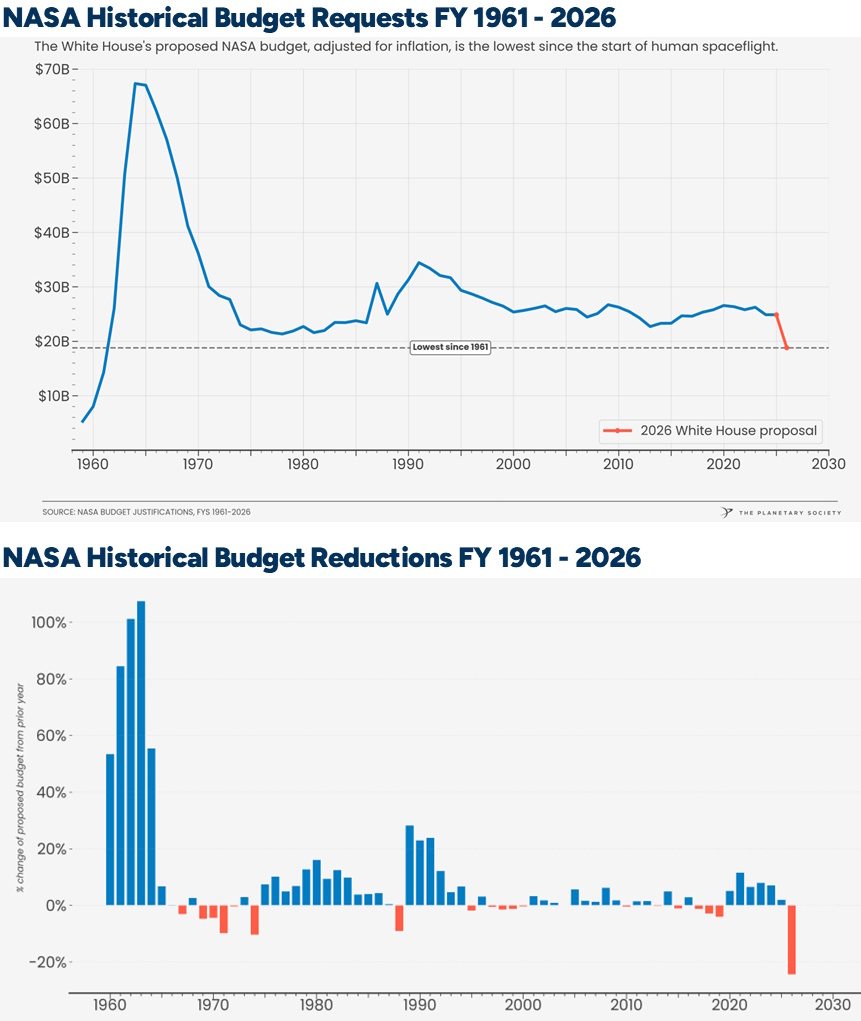
The top graph show the proposed White House FY 2026 budget (inflation-adjusted) for NASA, where the 2026 budget request is the lowest since 1961: when Alan Shepard became the first American in space. The lower graph shows the year-over-year change in budget requests, with the ~25% decrease from 2025 to 2026 marking the largest requested decrease in NASA’s entire history.
Certainly, the actions of the administration here in 2025 have been consistent with that ideology: to end funding for NASA science, including all of NASA Earth sciences, as well as NASA education and public outreach. Earlier in 2025, the Trump administration released their budget plan for the 2026 fiscal year (which begins October 1st), and it called for astounding, unprecedented cuts to NASA science. Some lowlights include:
- The total proposed budget for NASA was a decrease of $5.4 billion from the prior year, a 24% decrease, or the largest in agency history.
- The budget especially slashed the budget of the Science Mission Directorate — which includes Earth sciences, heliophysics, astrophysics, and planetary science — by a whopping 47%.
- The budget calls for the cancellation of a total of 41 missions and projects, and cuts funding to the International Space Station by over $300 million.
- The budget provides insufficient (or no) funding for future NASA flagship missions: LISA, the space-based successor to LIGO, the Nancy Roman Telescope, an already-constructed super-Hubble that’s awaiting launch, and the Habitable Worlds Observatory, the first-ever telescope that will be capable of directly imaging Earth-sized worlds at Earth-like distances around Sun-like stars, and our best hope for finding our first inhabited planet beyond Earth.
The space agency that revolutionized our view of the Universe through its flagship missions like Voyager, Hubble, Chandra, Spitzer, and JWST is at risk of having nearly its entire mission portfolio incinerated.
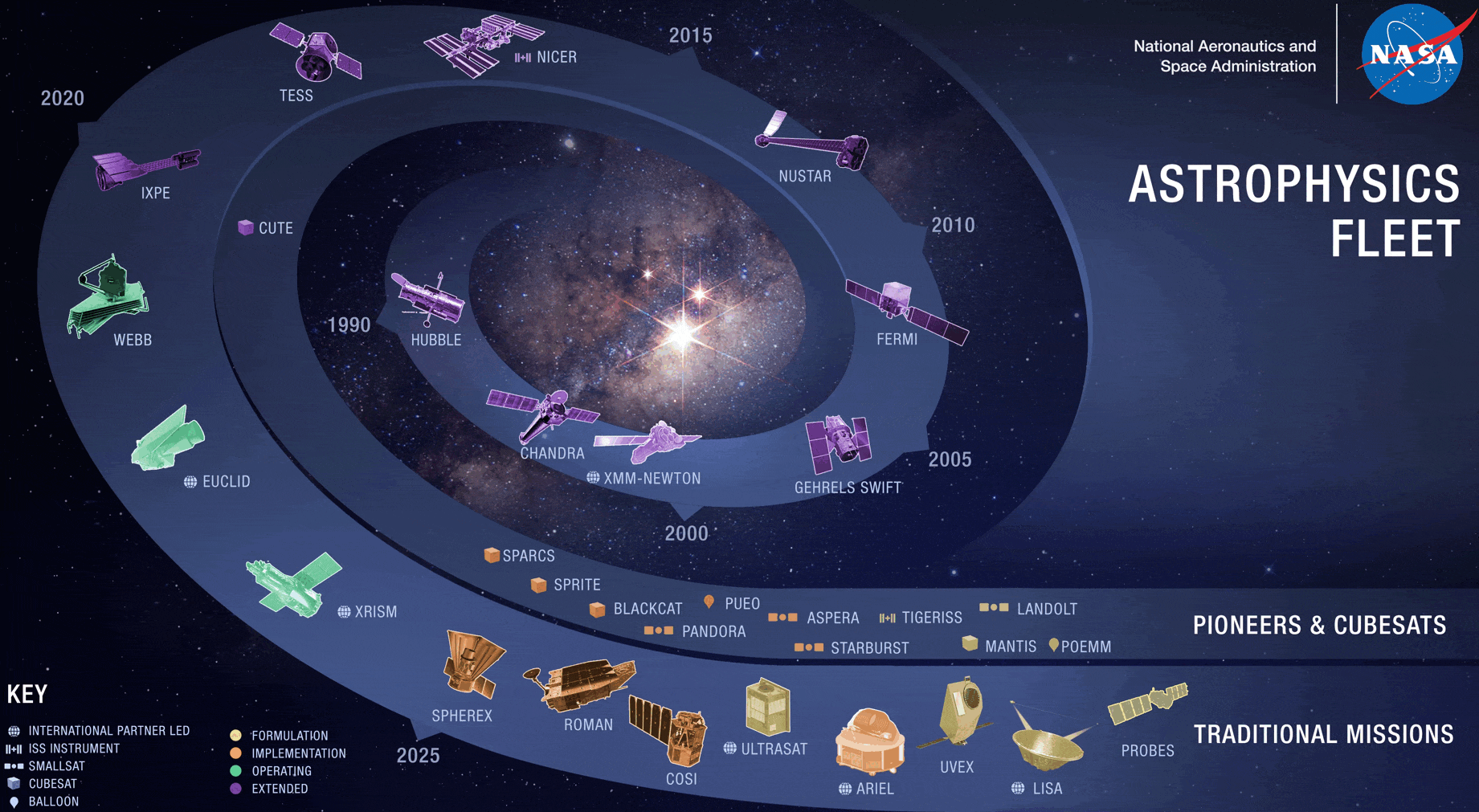
This animation switches between the planned NASA astrophysics fleet, as originally published by NASA in December of 2016, and the current budget proposal for the 2026 fiscal year for NASA astrophysics. With only a few notable exceptions, the entire portfolio of NASA astrophysics missions is slated to be eliminated.
These proposed cuts to NASA science are significantly harming not only the national security interests of the United States, but also the lives, safety, and resilience of citizens across the country and globe. While NASA’s astrophysics and planetary science divisions monitor and explore worlds and the Universe beyond our own, including potentially hazardous asteroids and comets, it’s NASA’s Earth science and heliophysics divisions that teach us things that directly impact our planet.
NASA’s Earth observing satellites and stations are key to monitoring climate, water resources, natural disasters and their impacts, air pollution, wildfires, droughts, and key infrastructure components all across the world. Satellite instruments monitor stores of groundwater, and can identify weather events even as they’re still forming over the oceans.
Meanwhile, space weather events present the greatest threat to our power grid, with the strongest solar flares and coronal mass ejections capable of causing blackouts, fires, and property damage whose cost can rise into the trillions of dollars. Just as we’re entering the era where we can finally observe space weather travel from the Sun all the way to Earth, cuts to both NASA heliophysics and the National Science Foundation’s flagship facility, the Daniel K. Inoue Solar Telescope, threaten to eliminate our ability to monitor and track these potentially devastating events.
Similarly, NASA’s directive to provide the “dissemination of information concerning its activities and the results thereof” is being eliminated entirely, as the budget reducing the funding of STEM programs — education and outreach programs concerned with science, technology, education, and mathematics — from $143 million down to $0.
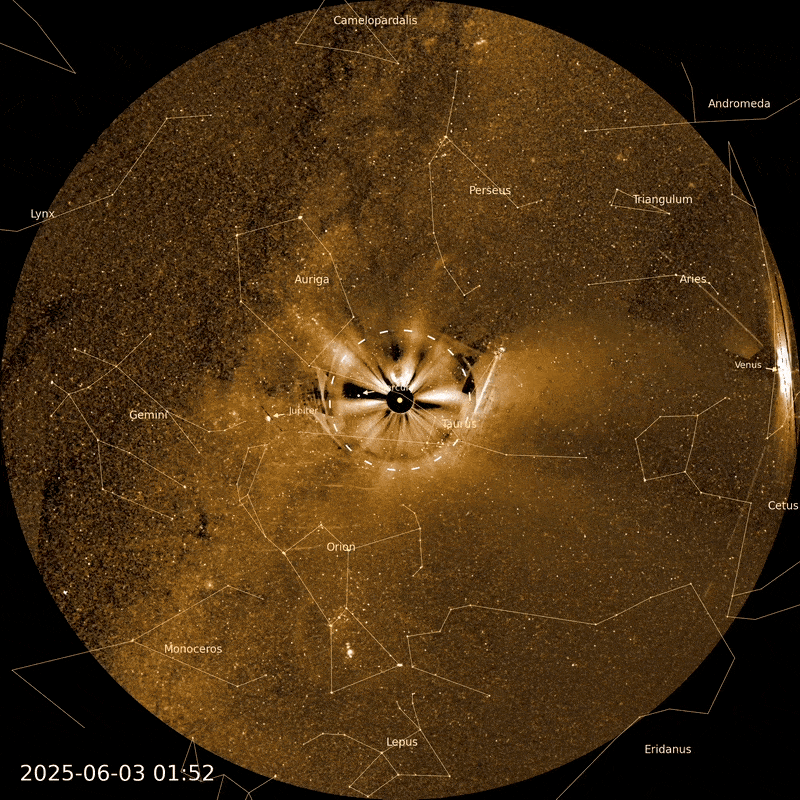
This clip from NASA’s PUNCH satellite shows a strong coronal mass ejection emanating from the Sun’s limb (top) on June 3, 2025: the first non-halo CME observed since the array of spacecraft was launched on March 11, 2025.
Overall, here in 2025, NASA has already laid off or fired more than 20% of its entire staff. The entire scope of NASA’s workforce has shrunk by some ~4000 employees since January of 2025: from around 18,000 down to about 14,000 at present. Most recently (on Monday, August 18th, or yesterday as this article is being written), NASA’s Senior Scientist for Astrobiology Strategy (and Carl Sagan Medal winner) Dr. David Grinspoon has confirmed that his term appointment will not be renewed, and that the position itself is being eliminated. The stated goal of the White House is to shrink the total number of NASA employees down to below 12,000: the lowest level since 1960.
This is in concert with many other cuts across the federal government, like the NSF’s proposed 57% budget cut. While the most prominent cuts have affected the senior staff, it’s actually the most junior, early career scientists that are facing the greatest impacts of these changes. Undergraduates are finding that the path towards the next step in their careers — of going to graduate school — have been closed off to them, as the cuts to University research have led to many of the most prominent graduate programs admitting zero new students for the coming academic year. Numerous fellowship and scholarship programs have been rescinded or terminated, leaving many graduate students and postdoctoral researchers without funding. Grants have been stalled, revoked, or simply have been left unpaid, leaving many with no options to continue their studies or careers in the United States.
The reality is that even if NASA’s budget is entirely restored, the loss of personnel, expertise, and mission continuity (resulting in an already in-process brain drain) is going to set science back by years or even decades with the harm that’s already been caused.
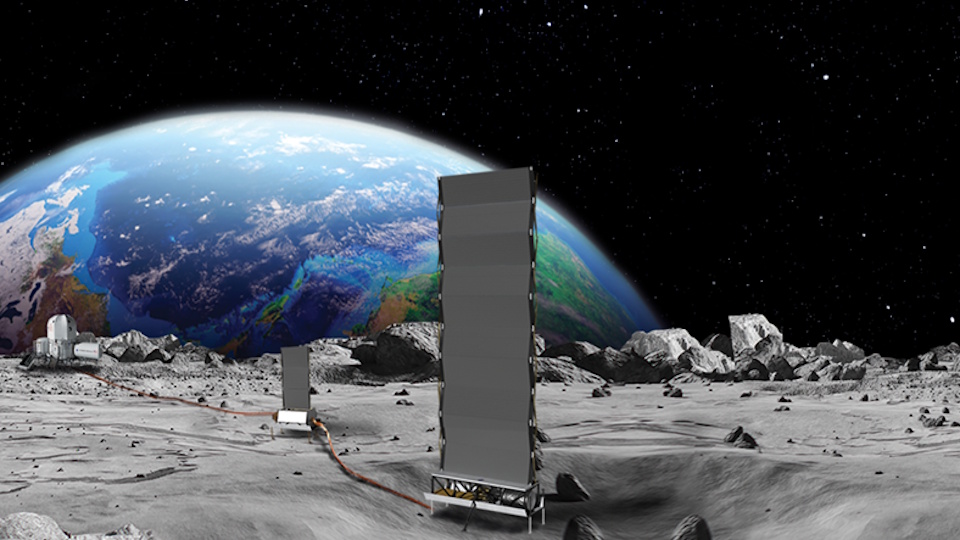
Humanity has long dreamed of establishing a robust and continuous presence on another world, such as the Moon or Mars. One of the keys to such a successful colony would be the continuous generation of power, with nuclear power plants remaining a prime, and arguably our best, option. However, mortgaging our present scientific expertise and our long-term scientific infrastructure in service of a lunar land grab is a recipe for stagnation and regression, not for world-class science.
Credit: NASA; edited by E. Siegel
Instead, NASA’s funding is being diverted away from endeavors that directly protect and inform United States citizens and policymakers — climate change’s impacts, ongoing scientific research, and employing scientists who provide an accurate National Climate Assessment, even basic safety precautions like environmental reviews for launches and re-entries — to instead invest in projects like a nuclear reactor on the Moon. As has been well-documented, that endeavor will likely result in:
- a rush to stake out “desired territory” on the Moon, such as peaks of eternal light or permanently shadowed craters at the lunar poles,
- to create and build a nuclear power plant, even a rudimentary (or non-functional) one,
- where the USA then uses the excuse of “managing radiation risks” to create an exclusionary “keep-out” zone,
- which effectively closes down that area of the Moon to all nations/states/entities that are non-owners of those plants,
exploiting a loophole in the Outer Space Treaty. You see, this 1967 treaty explicitly holds that exploration and use of outer space shall be carried out for the benefit of all humanity and not the provenance of any one nation, and that no claims of sovereignty or occupation will be recognized. However, under the guise of “promoting nuclear safety,” these territories will effectively be annexed for sole use by whoever builds a nuclear power plant there first: i.e., the United States.
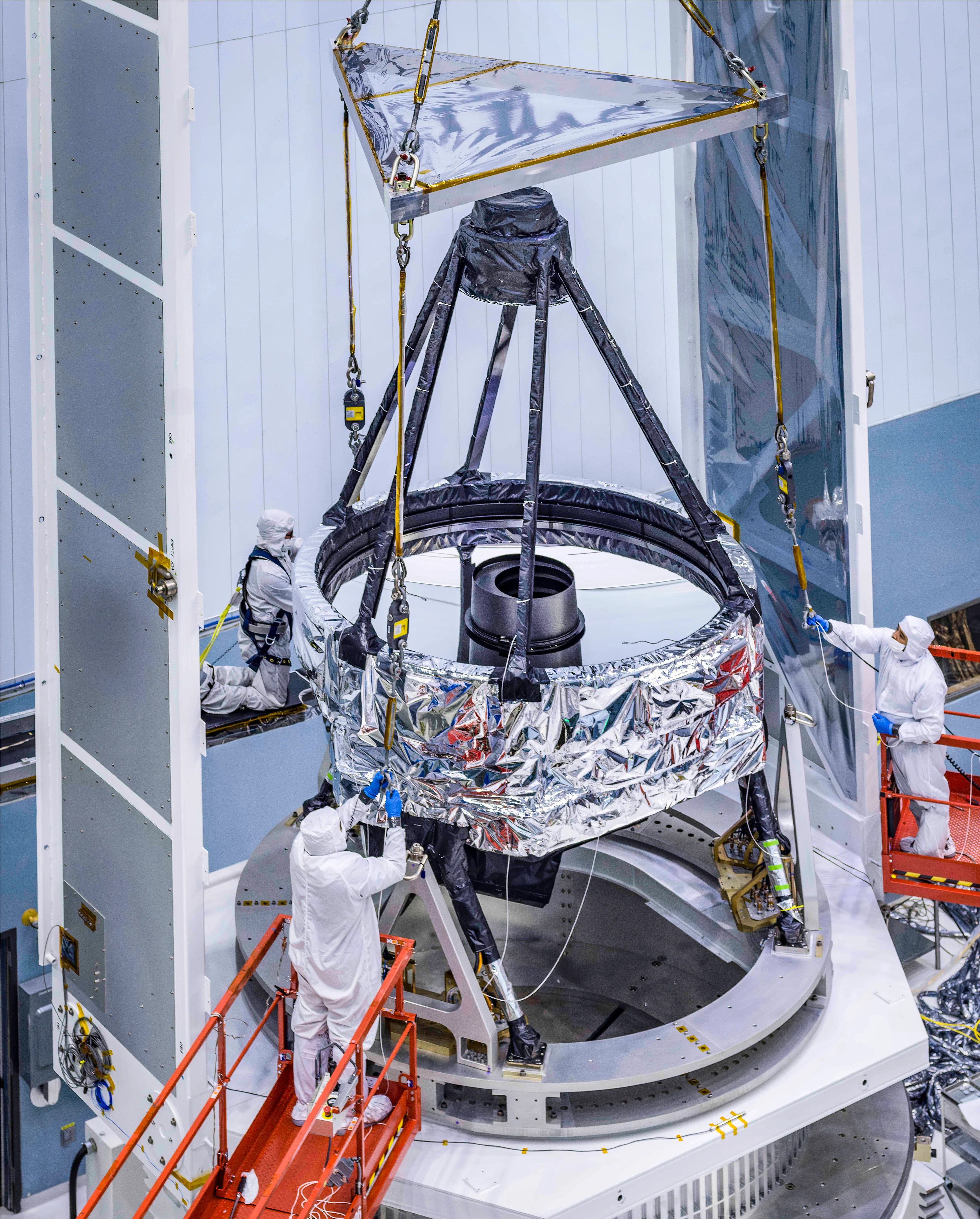
NASA’s Nancy Grace Roman telescope has completed construction and is nearly ready for launch. However, unless sufficient funding comes from the US government to launch and operate it, this telescope is in grave danger of never flying. A “Plan B” of gifting it to a country that would use it, even in defiance of national orders, must remain under consideration, especially as the October 1, 2025 deadline for the start of the next fiscal year looms.
As has been widely reported, these plans will not only damage science over both the short and long terms in the United States, making us less aware of and resilient against predictable, observable phenomena, but stand in direct defiance of NASA’s very charter itself. NASA’s charter calls for, very specifically, the following:
- that activities in space should be devoted to peaceful purposes for the benefit of all mankind,
- the general welfare and security of the United States require that adequate provision be made for aeronautical and space activities,
- [and that] such activities shall be the responsibility of, and shall be directed by, a civilian agency.
It also dictates, among the objectives of this space agency, the following are included:
- The expansion of human knowledge of phenomena in the atmosphere and space,
- The establishment of long-range studies of the potential benefits… involved in the utilization of aeronautical and space activities for peaceful and scientific purposes,
- The preservation of the role of the United States as a leader in aeronautical and space science and technology, [and]
- Cooperation by the United States with other nations and groups of nations in work done pursuant to this Act and in the peaceful application of the results, thereof.
It also violates the NASA charter, explicitly, that the current NASA administrator is also the current Secretary of Transportation, as the charter dictates that, “The Administrator and the Deputy Administrator shall not engage in any other business, vocation, or employment while serving as such.”
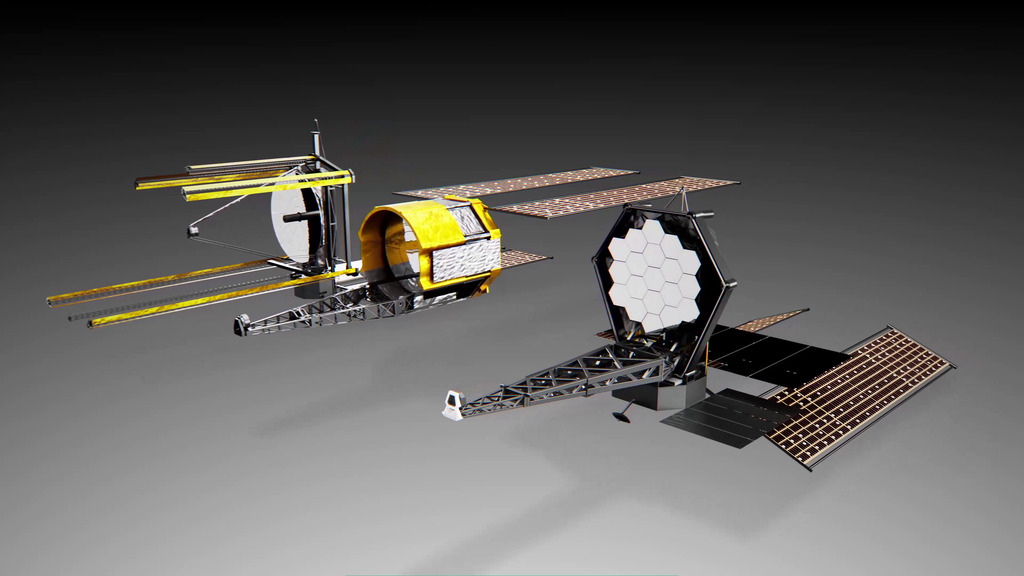
These two designs represent artist concepts for the potential look and architecture of the upcoming, planned NASA astrophysics flagship mission of HWO: the Habitable Worlds Observatory. It will represent a truly generational leap, the same way Hubble or JWST did for NASA science. As the #1 recommended mission by the National Academy of Sciences’ 2020 decadal survey, it will be the first mission to directly image Earth-sized worlds at Earth-like distances around Sun-like stars, but only if we design, advance, fund, and build it.
However, no one is holding the current administration accountable for these violations, and time is running out to preserve what remains of the world-class scientific infrastructure within the USA. The truth is that this is a five-alarm fire for not just NASA, but the entire country, and there are only a few weeks left to save what so many thousands of people have worked for generations to build. If a law altering the proposed budget for the next fiscal year is not passed by October 1, 2025, then the following executive order is likely to be enforced:
“I hereby order that, on October 1, 2025, direct spending budgetary resources for fiscal year 2026 in each non-exempt budget account be reduced by the amount calculated by the Office of Management and Budget in its report to the Congress of May 30, 2025.”
That will mark the end of funding for an enormous number of scientific endeavors, including for nearly all of NASA astrophysics, a sizeable chunk of NASA planetary science, most of NASA heliophysics, and most (or even potentially all) of NASA Earth science. For the first time, we have the scientific capability of answering perhaps the greatest existential question that humanity has had for the broader Universe: the question of whether life on Earth is truly alone or not. We have the tools, the talent, and the technology, at long last, to find out. If we don’t act, swiftly, to prevent those currently in power from achieving their destructive ambitions, this will instead mark the decade that NASA science needlessly comes to an unceremonious end.
Sign up for the Starts With a Bang newsletter
Travel the universe with Dr. Ethan Siegel as he answers the biggest questions of all.
